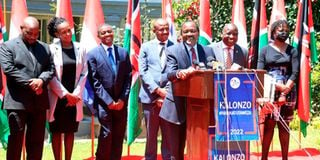Premium
The colours and flags are out

Wiper leader Kalonzo Musyoka addresses journalists at the SKM Command Centre in Nairobi on March 1, 2022.
What you need to know:
- Today it looks like there might not be a candidate like Mohamed Abduba Dida on a ticket this year.
- It seems like there might not be a major female candidate in the presidential race.
The short knives are out in the forthcoming Kenyan general election. In May, the long knives will be unsheathed.
Like elsewhere, Kenyan elections are not only about the ballot. They are also a conversation about how the country sees itself; the sounds and sights that are capturing its imagination; but also its underlying social and cultural shape. These are expressed in the type of candidates that put themselves forward; those who don’t; the popular symbols deployed; the language used; and how the gladiators dress.
It’s still a way to go, so things could change, but today it looks like there might not be a candidate like Mohamed Abduba Dida on a ticket this year. Dida was the maverick candidate for the 2013 election. He was a breath of fresh hair; quick-witted, unconventional, plain-speaking in an intelligent way, not pandering to established constituencies and a joy to listen to.
There was never any likelihood he would win. He was like the friend you know will not pay for the drinks or meal but you just have to have him on the night out. He was more intriguing in 2013; when he ran again in 2017, there was less novelty about him.
That there is little promise of a Dida points to one of the intriguing things about the 2017 election. That lively spark in Kenyan public life and outsider streak that Dida represented is gone. For all the blasters, this is a status quo election. It’s just that it is being dressed in some very fancy garments.
Another indicator of that is, it seems like there might not be a major female candidate in the presidential race, especially if Martha Karua doesn’t throw her hat in the ring. The likelihood of a female running mate for the perceived frontrunners, however, is more likely.
Toyota Landcruiser sunroof
If this comes to pass, it could be the result of a seeming contradiction in women’s rights politics. First, it seems to have become considerably mainstream and been co-opted in establishment politics. At the same time, women’s rights in Kenya have also become more alternative and escaped into social media, radical blogging and art, and podcasting.
The symbolism game has also changed. In the past few days, we saw that play out at the Orange Democratic Movement’s (ODM) National Governing Council meeting and the press conference by Wiper Party leader Kalonzo Musyoka, at which he set out his terms for joining the President Uhuru Kenyatta- and Raila Odinga-birthed Azimio la Umoja political umbrella organisation.
At the ODM meeting, they went over the top — this time with everyone wearing a shiny orange neck scarf. And, of course, the orange cap to boot. The weak-eyed would have needed those pair of glasses folks use to view the eclipse to take in the scene. The scarf has been sitting in the second row of Kenyan electoral politics. It has moved to the front.
At Kalonzo’s presser, behind him was lined the party flag, and then more Kenyan national flags that you could throw a hat at. The flag has always been an important election prop but things have changed up a bit. We are into Donald Trump-like “Make America Great Again” overkill territory with it.
The Toyota Landcruiser sunroof has also come of age. Politicians on the hustings used to favour standing on the bonnet of the car, offering the full view of the candidate — so the masses could see how tall or impressively potbellied they were.
Female running mate
It began to change in 2013, in the first campaign of the Uhuru Kenyatta-William Ruto “UhuRuto” ticket. Their bromance was at its height, and both men were reasonably slender, with the burden of office not yet showing on their waists. They needed to stand lower and make closer eye contact with the electorate, and to pull off a photogenic pairing with both of them in white shirts and, occasionally, matching red ties. They would both squeeze through the sunroof to achieve that effect.
That all seems to be very long ago. The bromance ended in tears and, today, you wouldn’t get Uhuru and Ruto to stand through the same stadium roof, let alone a Toyota Landcruiser’s.
The sunroof, however, is blossoming. We have seen all sorts of allies squeezing through the same sunroof. Things will get very interesting if any of the candidates chooses a female running mate. The social media memes will simply be priceless.
And — how can we forget — there is the floral shirt, brought to prominence by Uhuru during his addresses on Covid-19 in 2020. The move toward “African dress” had been on in Kenya for years. What Uhuru did was put the icing on the cake.
In all, it is a very bright and heavily flag-draped campaign season. So here we are.
When Uhuru is gone from State House, there will likely be the inevitable rosy-eyed review of his time, as is being done with his predecessor, President Mwai Kibaki. While he would like to be remembered as the great road and bridges builder, Uhuru’s enduring legacy might just be how Kenyan big men turn out.
Mr Onyango-Obbo is a journalist, writer, and curator of the “Wall of Great Africans”. @cobbo3





